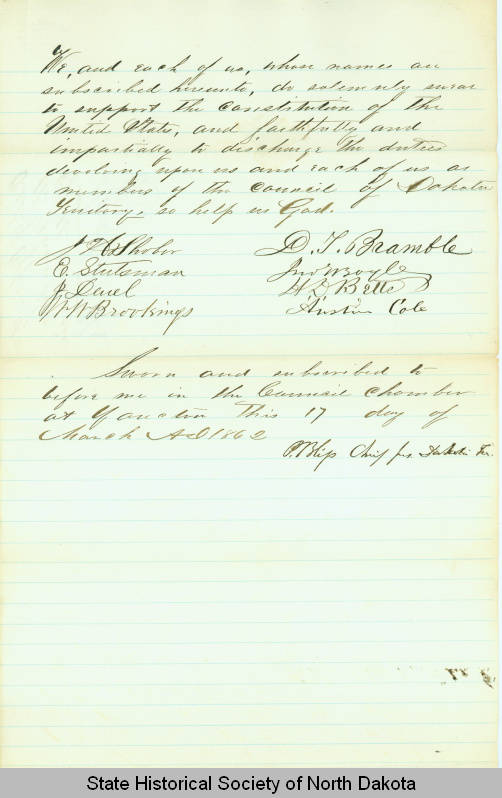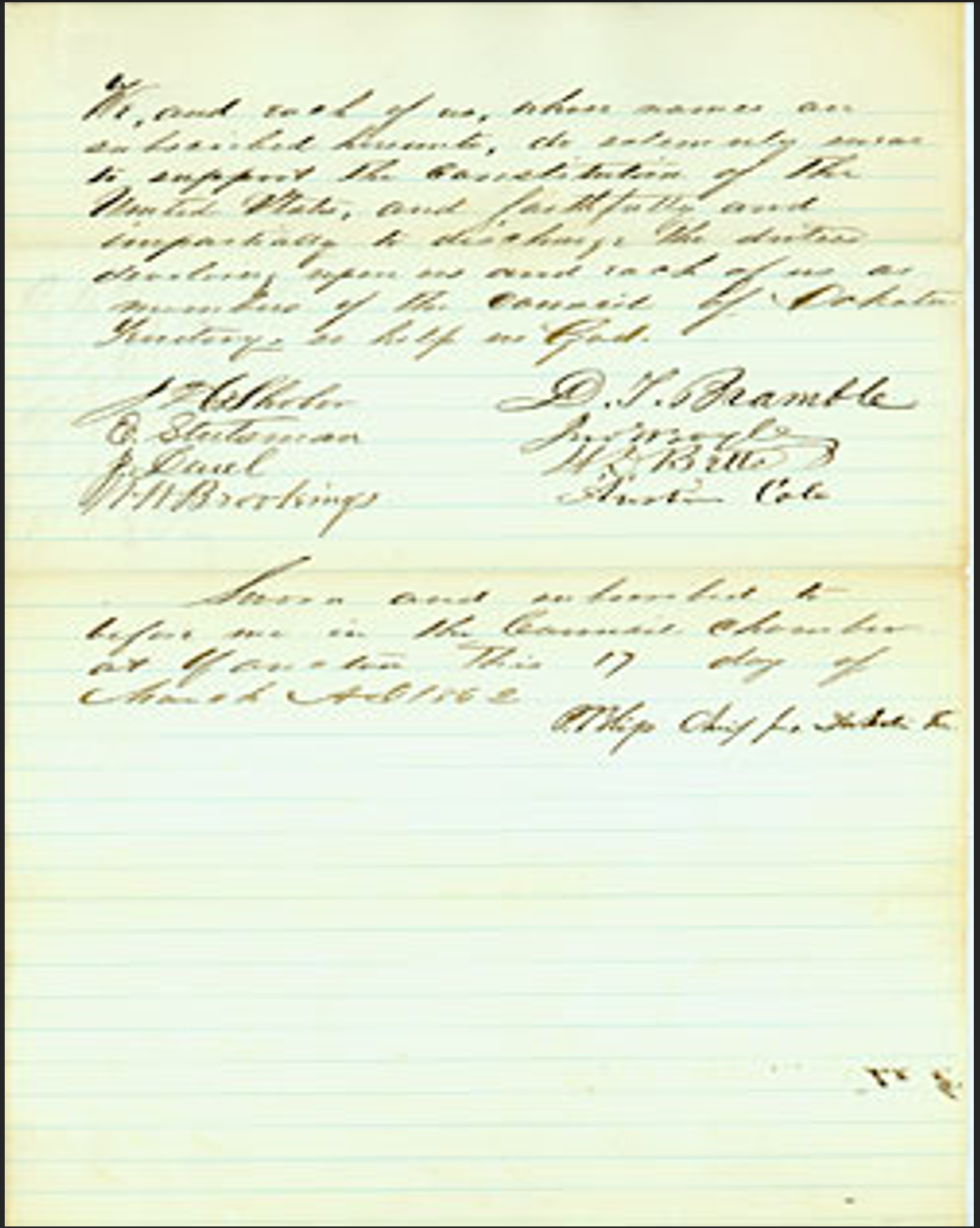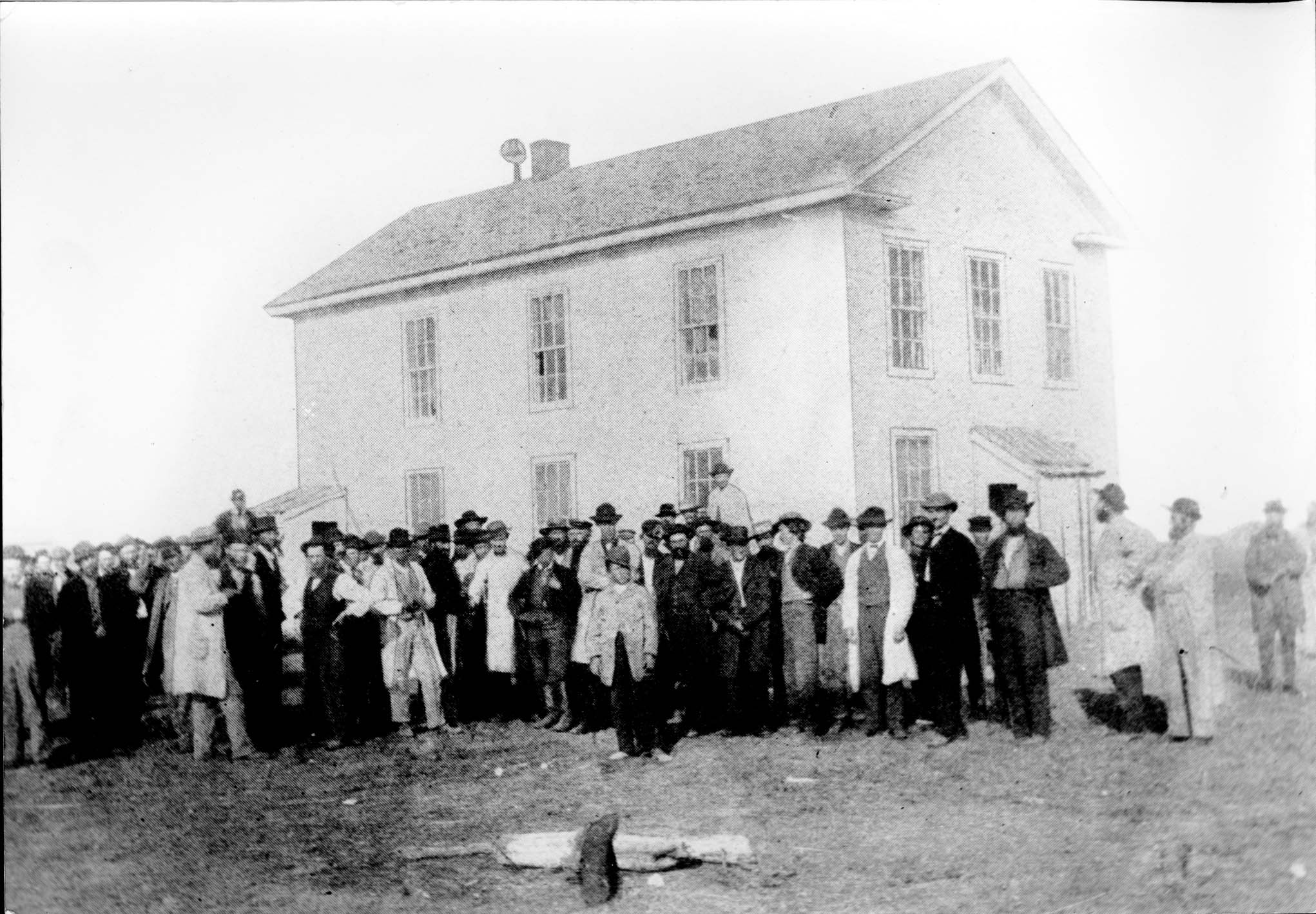The second supporting question, “how was Dakota Territory created?” helps students use primary sources to unwrap the context of the time and topic being examined. First part of Minnesota Territory, and then Nebraska Territory, Dakota Territory was created in 1861. The land that became Dakota Territory was acquired through various purchases and treaties, including the Louisiana Purchase the Treaty of Fort Laramie of 1868, and Old Crossing Treaty.
Facilitate a class discussion on the following questions:
- What were the first major European and American communities established in Dakota Territory? Where where they located? Why?
- Why were the residents of eastern Dakota so anxious for a government?
- What could they do without a government?
- What could they do only with a government?
- Can a society function without a government?
- Other than criminal law, what laws are necessary?
- What is needed to enforce laws?
Complete the following task using the sources provided to build a context of the time period and topic being examined.
Formative Performance Task 2
Study sources A-K. Write a summary that answers the following questions:
- What types of sources are they (letters, photos, maps, diaries, etc.)?
- What is going on in these sources? What kind of information do they contain?
- Who created each of these sources?
- Who was the intended audience for each source?
- Why were these sources created?
- When were the sources created?
- What do the sources tell us about Dakota Territory?
- How many of the names of men mentioned in the territorial government document set can you find on modern maps of North Dakota or South Dakota?
- Was the change in the oath of office necessary? Why?
How do we know? What else can you find?
Featured Sources 2
The sources featured in this section are all primary sources. They are the raw materials of history—original documents, personal records, photographs, maps, and other materials. Primary sources the first evidence of what happened, what was thought, and what was said by people living through a moment in time. These sources are the evidence by which historians and other researchers build and defend their historical arguments, or thesis statements. When using primary sources in your lessons, invite students to use all their senses to observe, describe, and analyze the materials. What can they see, hear, feel, smell, and even taste? Draw on students’ knowledge to classify the sources into groups, to make connections between what they observe and what they already know, and to help them make logical claims about the materials that can be supported by evidence. Further research of materials and sources can either prove or disprove the students’ argument. These records are part of the Official Papers of the Governor Series No. 76, Box 1 and SHSND Archives Series 30076 Dakota Territory Governors Records, Folders 6, 7, 11.
On November 8, 1859, the residents of Dakota, at least those living near Brambles store in Yankton, met to request that Congress authorize the creation of a territory allowing for a civil government. Eastern Dakota had been part of Minnesota Territory until Minnesota became a state in 1858. (Western Dakota was part of a large unorganized territory that included Montana and Idaho.) Lacking a government and its stabilizing political structures, residents composed a memorial to Congress requesting civil status, but Congress did not respond until residents sent a second memorial on January 15, 1861. This time, Congress responded quickly, and President Buchanan signed the Organic Act creating Dakota Territory on March 2, 1861. When word finally reached Yankton on March 13, the residents celebrated, but the work of creating a new government began.
In 1861, President Abraham Lincoln appointed his personal physician, William Jayne of Springfield, Illinois as governor of the new territory of Dakota. Other high-ranking territorial officials were also appointed by the president. The territorial governor then appointed some officials, such as constable, and justice of the peace. Other officials were elected. The residents of the territory (most living in Yankton or nearby in the extreme southeastern part of the territory which is now South Dakota) elected representatives to the territorial legislature (Council and House of Representatives) and other offices such as state treasurer. The first legislature was elected on September 16, 1861 and met for the first time on March 17, 1862. They completed their work on May 15. They established the territorial capital at Yankton, drew the boundaries of eighteen counties, passed a civil code, criminal code, and other laws providing for common schools, elections, taxation, and divorce. Many of these laws were inadequate, and few would be enforced in the next few years.
Slowly, counties organized in the southern portion of the territory, but also in the extreme northeast county (Pembina) where European American settlement had been underway since shortly after 1800. The territory had to provide governmental services for the small but persistently growing population. Officials had to establish and maintain law, build roads, organize counties, townships, and school districts.
Governor Jayne served for just two and one-half years and then returned to Illinois. Jayne recommended as his replacement Newton Edmunds, a native of New York who had come to Dakota Territory in 1861 and had served as a clerk in the Surveyor’s office. Edmunds was conscientious as governor. He knew the territory had to have agencies that would promote the well-being of the residents and allow it to grow economically. However, the young territory was often unable to enforce laws, fund agencies, and provide the necessary functions of government. An effective government was necessary to support ordinary commerce and family life in the territory. Edmunds was also appointed Indian commissioner for Dakota Territory. During his term of office, relations between the increasing population of European Americans and the many tribes of Native Americans in the territory were in a state of crisis. The Dakota War of 1862, which began in southern Minnesota when the Dakota rebelled against an unjust agent, spilled over into northern Dakota Territory. Many bands of Dakota fled west and north pursued by General Alfred Sully. Sully carelessly attacked any band of Indians he came across which led to more hostilities. Edmunds called for treaty councils to try to bring peace to the territory.
When Governor Edmunds spoke to the legislature in 1863, he called for new laws including the election of a state superintendent of instruction, more stringent election laws, and the creation of a fund to foster immigration to Dakota Territory. Later that year, Edmunds' plans began to take effect. The state auditor, Justus Townsend recommended that the territory impose a 5 mill tax on each dollar value of real and personal property. The first State Superintendent of Public Instruction, James S. Foster, had little work to do because there were no public schools in the territory, but he gathered some statistics and presented a plan for funding schools. His report cited 600 school age children in the territory, but no school taxes had been collected. In fact, few taxes or fines had been collected at all. If these laws were enforced, the schools could be funded. Taking small steps, the governor, the legislature, and other elected and appointed officials began to create a civil government in Dakota Territory.
| Source A |
|
| Source B |
Journalist and historian George W. Kingsbury arrived soon after Dakota became a territory. Years later he wrote from the stories he had heard of the joy that the signing of the Organic Act brought to the residents of the extreme southeast portion of the huge new territory. There was "...no telegraph...so the good tidings traveled slowly. But it reached Dakota and found the pioneers in a mood to receive it and give it a most generous welcome. It is said that the shouts of joy that went up made the welkin ring* and started a jack rabbit stampede for the distant bluffs that was a sight to behold. Laboring men (and all were of this honorable class) took a day off and went about congratulating one another in language vigorous; there were handshakes that would abash a pump handle in energetic motion, and laughter loud and long and hearty, and other smiles. Songs were sung and jigs were danced and eloquent speeches of excellent quality and generous quantity were a feature of the joyous occasion. There were no bonfires, but an abundance of hot air and fervid works. It was a never-to-be-forgotten occasion and the enactment of the law was rightly regarded as an important progressive step in Dakota's career." * "made the welkin ring" is an old phrase to indicate a lot of noise Kingsbury, George W. History of Dakota Territory vol 1 pt 1 (Chicago: The S. J. Clarke Publishing Company, 1915), 169. |
| Source C |
Governor Newton Edmunds
Governor Jayne and the first legislature established the basic framework of government. Governor Jayne resigned less than two years after taking office. On November 2, 1863, Newton Edmunds was appointed by President Lincoln as the second territorial governor. The territorial government was not yet operating smoothly: there were no public schools, few roads to connect the distant settlements, no tax collection, and no systematic law enforcement. Edmunds' task was to make the government and the territory function to make it appealing to settlers and business. His frustration at the absence of appointed officials who may not have found Dakota an appealing place to work is apparent in the letter dated February 3, 1865 to Dakota's representative to Congress Walter W. Burleigh. |
| Source D |
December 24, 1864
|
| Source E |
January 29, 1865 [From Seth Pollock]
|
| Source F |
February 2, 1865 [Response to Seth Pollock]
|
| Source G |
February 3, 1865 [to Walter A. Burleigh]
|
| Source H |
The first state House of Representatives consisted of thirteen members. The Council had nine members including J. S. Gregory who was not present for the oath. This tiny gathering of twenty-two respected men from every organized district of the territory had the responsibility of creating a new government. All had been born in eastern states and many would return to the states in a few years to resume family or business responsibilities. William Jayne took his oath of office in Washington, D.C. with a Justice of the Supreme Court presiding. He had probably not yet appeared in Dakota Territory when on June 1, 1861 the citizens of the territory met at Vermillion (no capital had been established yet) to declare their allegiance to the Union. From that point on, Dakota Territory (and later North Dakota) would be a Republican stronghold. The members of the first territorial legislature simply swore to support the U. S. Constitution. By 1863, with the Civil War raging to the east and south, a far longer oath for legislators included the following section: “…[we] solemnly swear that we have never voluntarily borne arms against the United States since we have been citizens thereof; that we have voluntarily given no aid, countenance, counsel or encouragement to persons engaged in armed hostility thereto; that we have neither sought nor accepted nor attempted to exercise the function of any office whatever under any authority or pretended authority with hostility to the United States…” SHSND Archives Official Papers of the Governor Series 30076, Fld 11. The loyalty of early Dakotans is not surprising for many reasons. Most government officials came from northern states such as New York (Governor Edmunds) or Indiana (Enos Stutsman) where pro-Union sentiment was very strong. In addition, appointed officials depended on good relations with Republican presidents to maintain their positions and the territory depended on the Republican controlled Congress for all kinds of support. |
| Source I |
Oath of Dakota Territorial Council
|
| Source J |
Oath of House of Representatives
|
| Source K |
Territorial Capitol Building, Yankton, Dakota Territory
|
Learn more about governors of Dakota Territory.



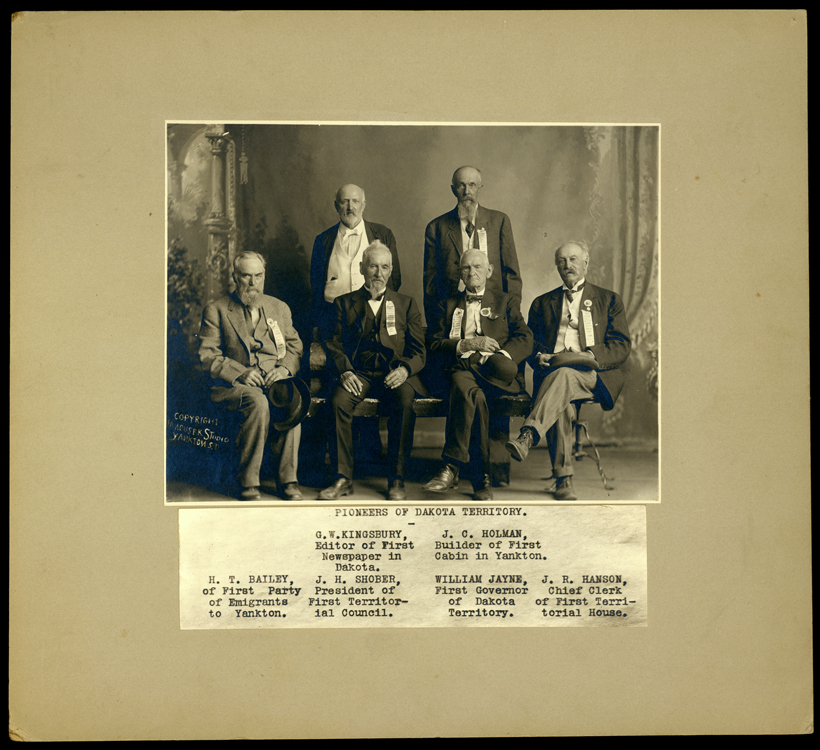
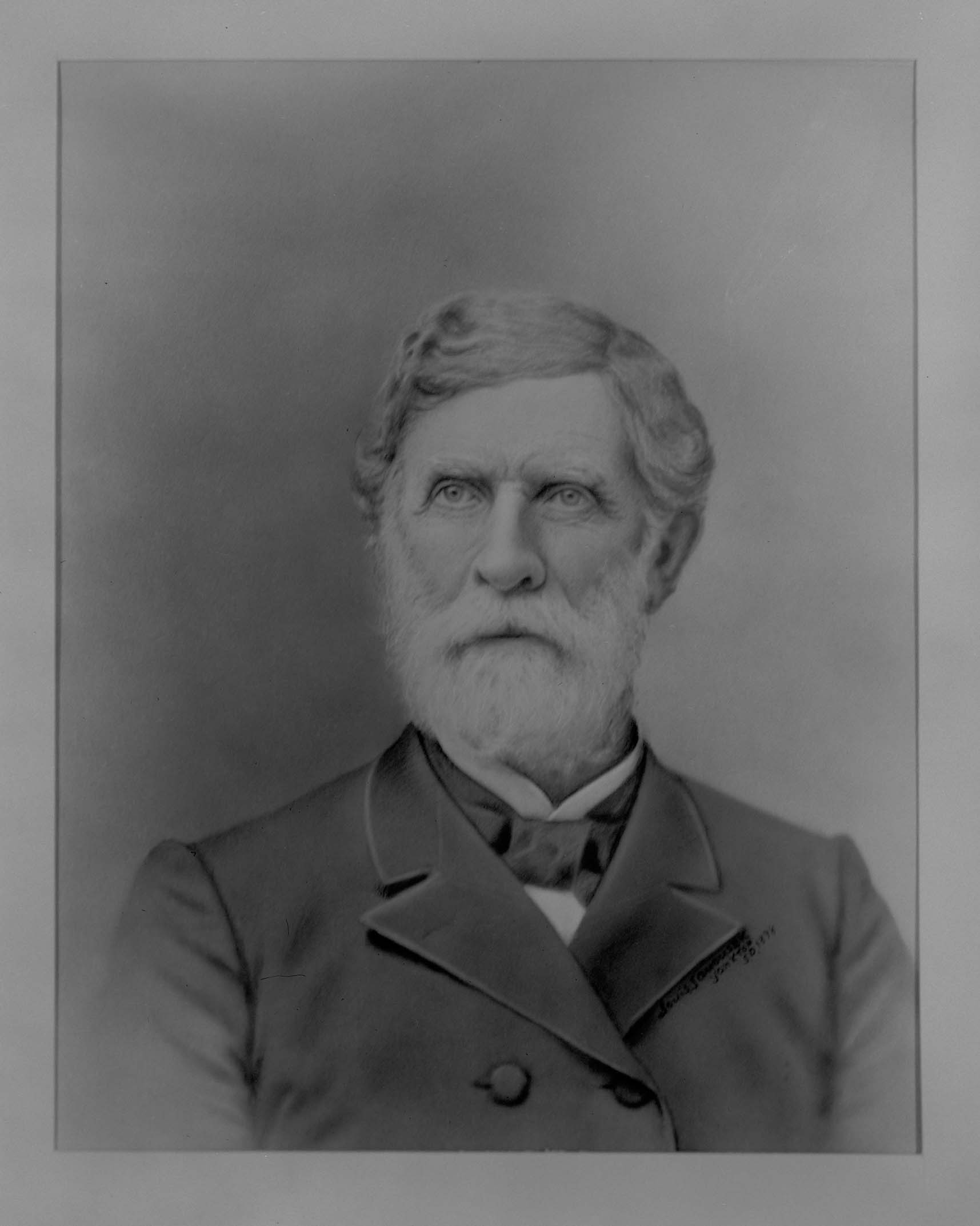
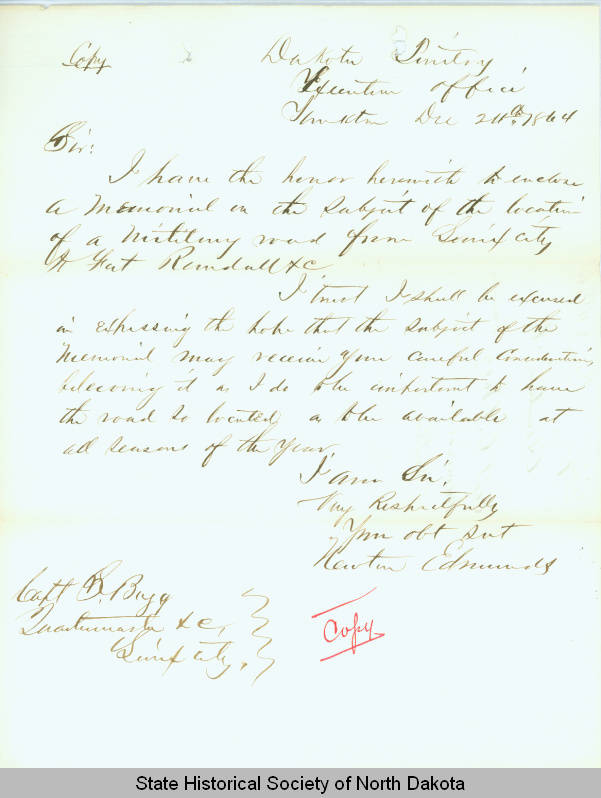
![January 29, 1865 [From Seth Pollock]](/hs/sites/default/files/inline-images/January%2029%2C%201865%20%5BFrom%20Seth%20Pollock%5D.jpg)
![February 2, 1865 [Response to Seth Pollock]](/hs/sites/default/files/inline-images/February%202%2C%201865%20%5BResponse%20to%20Seth%20Pollock%5D.jpg)
![February 3, 1865 [to Walter A. Burleigh]](/hs/sites/default/files/inline-images/February%203%2C%201865%20%5Bto%20Walter%20A.%20Burleigh%5D.jpg)
